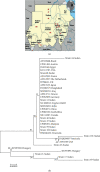Molecular Phylogenetic Analysis of 16S rRNA Sequences Identified Two Lineages of Helicobacter pylori Strains Detected from Different Regions in Sudan Suggestive of Differential Evolution
- PMID: 33178282
- PMCID: PMC7609147
- DOI: 10.1155/2020/8825718
Molecular Phylogenetic Analysis of 16S rRNA Sequences Identified Two Lineages of Helicobacter pylori Strains Detected from Different Regions in Sudan Suggestive of Differential Evolution
Abstract
Background: Helicobacter pylori (H. pylori) is ubiquitous among humans and one of the best-studied examples of an intimate association between bacteria and humans. Phylogeny and Phylogeography of H. pylori strains are known to mirror human migration patterns and reflect significant demographic events in human prehistory. In this study, we analyzed the molecular evolution of H. pylori strains detected from different tribes and regions of Sudan using 16S rRNA gene and the phylogenetic approach. Materials and methods. A total of 75 gastric biopsies were taken from patients who had been referred for endoscopy from different regions of Sudan. The DNA extraction was performed by using the guanidine chloride method. Two sets of primers (universal and specific for H. pylori) were used to amplify the 16S ribosomal gene. Sanger sequencing was applied, and the resulted sequences were matched with the sequences of the National Center for Biotechnology Information (NCBI) nucleotide database. The evolutionary aspects were analyzed using MEGA7 software.
Results: Molecular detection of H. pylori has shown that 28 (37.33%) of the patients were positive for H. pylori and no significant differences were found in sociodemographic characteristics, endoscopy series, and H. pylori infection. Nucleotide variations were observed at five nucleotide positions (positions 219, 305, 578, 741, and 763-764), and one insertion mutation (750_InsC_751) was present in sixty-seven percent (7/12) of our strains. These six mutations were detected in regions of the 16S rRNA not closely associated with either tetracycline or tRNA binding sites; 66.67% of them were located in the central domain of 16S rRNA. The phylogenetic analysis of 16S rRNA sequences identified two lineages of H. pylori strains detected from different regions in Sudan. The presence of Sudanese H. pylori strains resembling Hungarian H. pylori strains could reflect the migration of Hungarian people to Sudan or vice versa.
Conclusion: This finding emphasizes the significance of studying the phylogeny of H. pylori strains as a discriminatory tool to mirror human migration patterns. In addition, the 16S rRNA gene amplification method was found useful for bacterial identification and phylogeny.
Copyright © 2020 Abeer Babiker Idris et al.
Conflict of interest statement
The authors declare that there are no conflicts of interest.
Figures



Similar articles
-
Identification of functional tumor necrosis factor-alpha promoter variants associated with Helicobacter pylori infection in the Sudanese population: Computational approach.World J Gastroenterol. 2022 Jan 14;28(2):242-262. doi: 10.3748/wjg.v28.i2.242. World J Gastroenterol. 2022. PMID: 35110948 Free PMC article.
-
HELICOBACTER PYLORI cagA VIRULENCE GENE AND SEVERE ESOGASTRODUODENAL DISEASES: IS THERE AN ASSOCIATION?Arq Gastroenterol. 2021 Oct-Dec;58(4):468-475. doi: 10.1590/S0004-2803.202100000-85. Arq Gastroenterol. 2021. PMID: 34909852
-
[Comparison of four different primer sets for detection of Helicobacter pylori in gastric biopsies and oral samples by using real-time PCR].Pathol Biol (Paris). 2009 Feb;57(1):30-5. doi: 10.1016/j.patbio.2008.07.008. Epub 2008 Oct 7. Pathol Biol (Paris). 2009. PMID: 18842355 French.
-
Helicobacter pylori and other Helicobacter species DNA in human bile samples from patients with various hepato-biliary diseases.World J Gastroenterol. 2006 Apr 14;12(14):2181-6. doi: 10.3748/wjg.v12.i14.2181. World J Gastroenterol. 2006. PMID: 16610018 Free PMC article.
-
DNA diagnostics for reliable and universal identification of Helicobacter pylori.World J Gastroenterol. 2021 Nov 7;27(41):7100-7112. doi: 10.3748/wjg.v27.i41.7100. World J Gastroenterol. 2021. PMID: 34887630 Free PMC article. Review.
Cited by
-
Green Synthesis of Silver Nanoparticles by Cytobacillus firmus Isolated from the Stem Bark of Terminalia arjuna and Their Antimicrobial Activity.Biomolecules. 2021 Feb 10;11(2):259. doi: 10.3390/biom11020259. Biomolecules. 2021. PMID: 33578957 Free PMC article.
-
First insights into the molecular basis association between promoter polymorphisms of the IL1B gene and Helicobacter pylori infection in the Sudanese population: computational approach.BMC Microbiol. 2021 Jan 7;21(1):16. doi: 10.1186/s12866-020-02072-3. BMC Microbiol. 2021. PMID: 33413117 Free PMC article.
-
Identification of functional tumor necrosis factor-alpha promoter variants associated with Helicobacter pylori infection in the Sudanese population: Computational approach.World J Gastroenterol. 2022 Jan 14;28(2):242-262. doi: 10.3748/wjg.v28.i2.242. World J Gastroenterol. 2022. PMID: 35110948 Free PMC article.
-
Lupin, a Unique Legume That Is Nodulated by Multiple Microsymbionts: The Role of Horizontal Gene Transfer.Int J Mol Sci. 2023 Mar 30;24(7):6496. doi: 10.3390/ijms24076496. Int J Mol Sci. 2023. PMID: 37047476 Free PMC article. Review.
-
First insights into molecular basis identification of 16 s ribosomal RNA gene of Staphylococcus aureus isolated from Sudan.BMC Res Notes. 2021 Jun 25;14(1):240. doi: 10.1186/s13104-021-05569-w. BMC Res Notes. 2021. PMID: 34172074 Free PMC article.
References
-
- Munoz-Ramirez Z. Y., Mendez-Tenorio A., Kato I., et al. Whole genome sequence and phylogenetic analysis show Helicobacter pylori strains from Latin America have followed a unique evolution pathway. Frontiers in Cellular and Infection Microbiology. 2017;7 doi: 10.3389/fcimb.2017.00050. - DOI - PMC - PubMed
LinkOut - more resources
Full Text Sources

